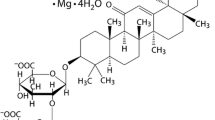Summary
The effects of hepatic ischemia/reperfusion (I/R) injuries on hepatocellular viability and store-operated calcium current (Isoc) in isolated rat hepatocytes and the effects of 2-APB on store-operated calcium current (Isoc) in isolated rat hepatocytes after hepatic ischemia/reperfusion injuries were studied. Hepatic ischemia and reperfusion injury model was establised and whole cell patch-clamp techniques were used to investigate the effects of 2-APB on Isoc. The results showed that ischemia/reperfusion injuries could significantly reduce hepatocellular viability and further increase Isoc in hepatocyte and 2-APB (20, 40, 60, 80, 100 μmol/L) produced a concentration-dependent decrease of Isoc with IC50 value of 64.63±10.56 μmol/L (n=8). It was concluded that ischemia/ reperfusion injuries could reduce hepatocellular viability, probably through increased Isoc in hepatocytes and 2-APB had a protective effect on ischemia/reperfusion-induced liver injury, probably though inhibiting Isoc.
Similar content being viewed by others
References
Putney J W Jr, McKay R R. Capcitative calcium entry channels. Bioessays, 1999, 21:38
Barritt G J. Receptor-activated Ca2+ inflow in animal cells: a variety of pathways tailored to meet different intracellular Ca2+ signaling requirements. Biochem J, 1999, 337:153
Fierro L, Parekh A B. Substantial depletion of the intracellular Ca2+ store is require for macroscopic activation of the Ca2+ release-activated Ca2+ current in rat basophilic leukemia cell. J Physiol, 2000, 522(2):247
Rychkov G, Brereton H M, Harland M Let al. Plasma membrane Ca2+ release-activated Ca2+ channel with a high selectivity for Ca2+ identified by patch-clamp recording in rat liver cells. Hepatology, 2001, 33:938
Maruyama T, Kanaji T, Nakade Set al. 2-APB, 2-aminoethoxydiphenyl borate, a membrane-penetrable modulator of ins (1,4,5) P3-induce Ca2+ release. J Biochem, 1997, 122(3):498
Iwasaki H, Mori Y, Uchida Ket al. 2-aminoethoxydiphenyl borate (2-APB) inhibits capacitative calcium entry independently of the function of inositol 1, 4, 5-trisphospate receptors. Receptors Channels, 2001, 7(6): 429
Bootman M D, Collins T J, Mackenzie Let al. 2-aminoethoxydiphenyl borate (2-APB) is a reliable blocker of store-operated calcium entry but an inconsistent inhibitor of ins (1,4,5) P3-induce Ca2+ release. FASEB J, 2002, 16(10):1145
Colletti L M, Remick D G, Burtch G Det al. Role of tumor necrosis factor-alpha in the pathophysiologic alterations after hepatic ischemia/reperfusion injury in the rat. J Clin Invest, 1990, 85(6):1936
Alpini G, Phillips J O, Vroman Bet al. Recent advances in the isolation of liver cells. Hepatology, 1994, 20(2):494
Barros L F, Stutzin A, Calixto Aet al. Nonselective cation channel as effectors of free radical-induced rat liver cell necrosis. Hepatology, 2001, 33(1):114
Fan C, Zwacka R M, Engelhardt J F. Therapeutic approaches for ischemia/reperfusion injury in the liver. J Mol Med, 1999, 77:577
Losser M R, Payen D. Mechanisms of liver damage. Semin Liver Dis, 1996, 16(4): 357
Broad L M, Braun F J, Livremont J Pet al. Role of phospholipase C-inositol 1, 4, 5-trisphosphate pathway in calcium release-activated calcium current and capacitative calcium entry. J Biol Chem, 2001, 276(19): 15 945
Trebak M, St J Bird G, McKay R Ret al. Signaling mechanism for receptor-activated canonical transient receptor potential 3 (TRPC3) channels. J Biol Chem, 2003, 278(18):16 244
Chapham D E, Runnels L W, Strubing C. The TRP ion channel family. Nature Reviews Neuroscience, 2001, 2 (6): 387
Ma H T, Patterson R L, Van Rossum D Bet al. Requirement of the inositol triphosphate receptor for activation of store-operated Ca2+ channels. Science, 2000, 287(5458): 1647
Kukkonen J P, Lund P E, Akerman K E. 2-aminoethoxydiphenylborate reveals heterogeneity in receptor-activated Ca2+ discharge and store-operated Ca2+ influx. Cell Calcium, 2001, 30(2): 117
Author information
Authors and Affiliations
Additional information
Huang Changzhou, male, born in 1965, M. D., Ph.D.
This project was supported by the National Natural Science Foundation of China (No. 30270532), the Trans-Century Excellent Talent Development Plan Fund of Ministry of Education of China (Official Letter No. 2002-48) and Shuguang Program Project of Shanghai Educational Committee (No. 02SG20).
Rights and permissions
About this article
Cite this article
Changzhou, H., Zongming, Z. & Fazu, Q. Effects of 2-APB on store-operated Ca2+ channel currents of hepatocytes after hepatic ischemia/reperfusion injury in rats. Current Medical Science 25, 39–41 (2005). https://doi.org/10.1007/BF02831382
Received:
Published:
Issue Date:
DOI: https://doi.org/10.1007/BF02831382




